Business Environment Report: Stakeholder Requirements and Firms
VerifiedAdded on 2023/01/11
|7
|1380
|90
Report
AI Summary
This report delves into the intricacies of the business environment, examining various organizational structures such as functional, divisional, matrix, and flat structures. It provides a comparative analysis of two prominent firms, J Sainsbury plc and Tesco plc, highlighting their missions, visions, purposes, and scopes. The report further explores the requirements of key stakeholders within J Sainsbury plc, including employees, suppliers, customers, government, and shareholders, emphasizing their contributions to the company's profitability and operations. The conclusion summarizes the importance of understanding the business environment and the significance of stakeholder relationships in achieving organizational success. The report references various books, journals, and online resources to support its findings.
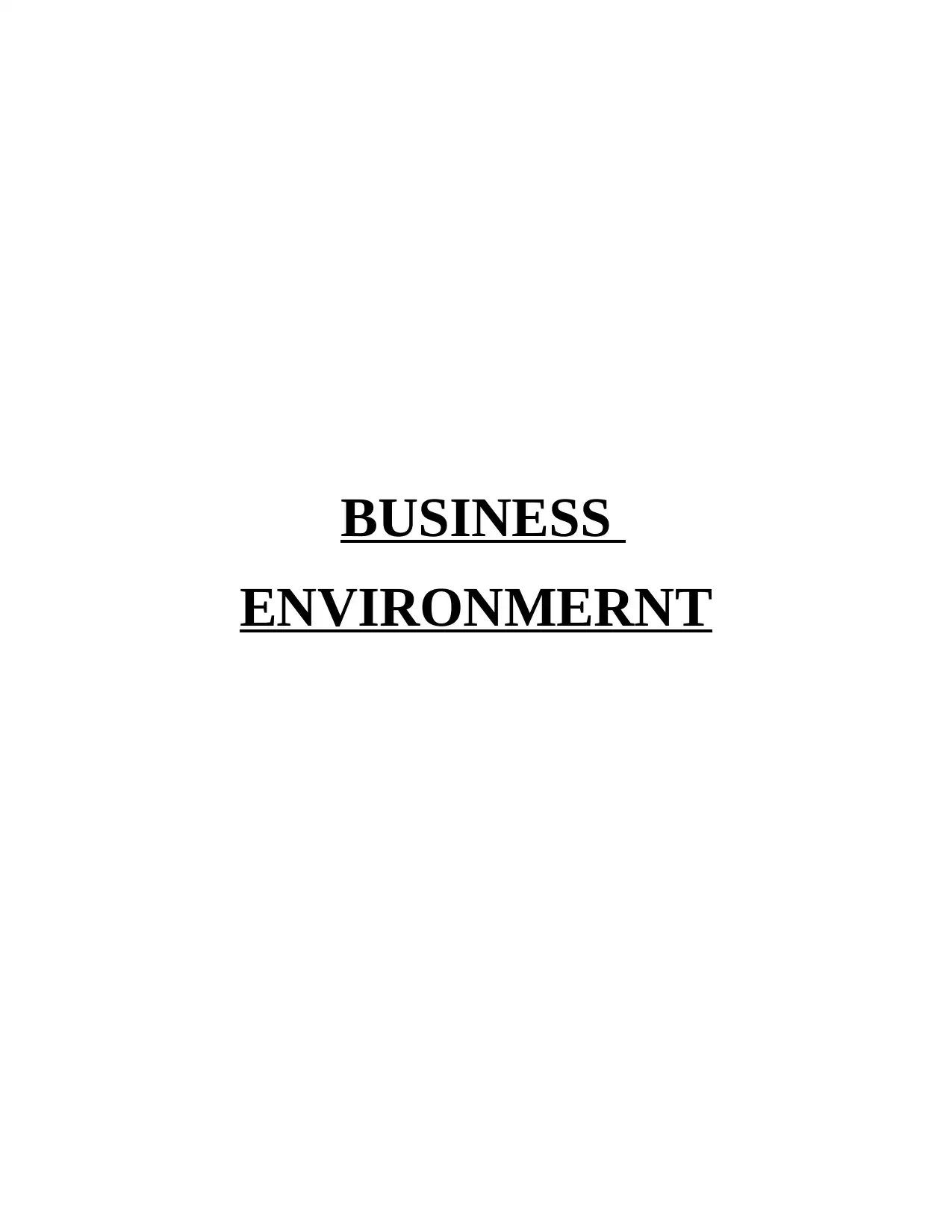
BUSINESS
ENVIRONMERNT
ENVIRONMERNT
Paraphrase This Document
Need a fresh take? Get an instant paraphrase of this document with our AI Paraphraser
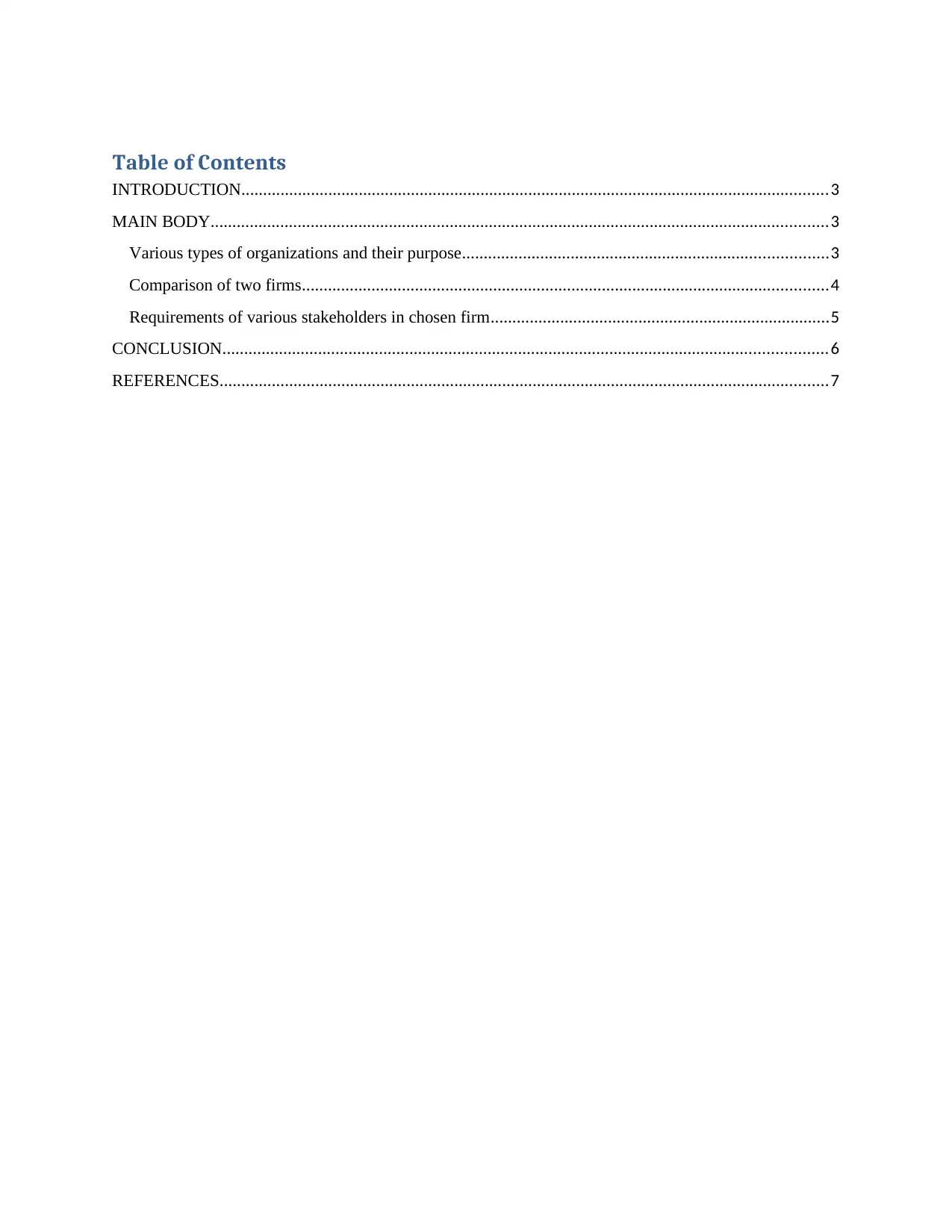
Table of Contents
INTRODUCTION.......................................................................................................................................3
MAIN BODY..............................................................................................................................................3
Various types of organizations and their purpose....................................................................................3
Comparison of two firms.........................................................................................................................4
Requirements of various stakeholders in chosen firm..............................................................................5
CONCLUSION...........................................................................................................................................6
REFERENCES............................................................................................................................................7
INTRODUCTION.......................................................................................................................................3
MAIN BODY..............................................................................................................................................3
Various types of organizations and their purpose....................................................................................3
Comparison of two firms.........................................................................................................................4
Requirements of various stakeholders in chosen firm..............................................................................5
CONCLUSION...........................................................................................................................................6
REFERENCES............................................................................................................................................7
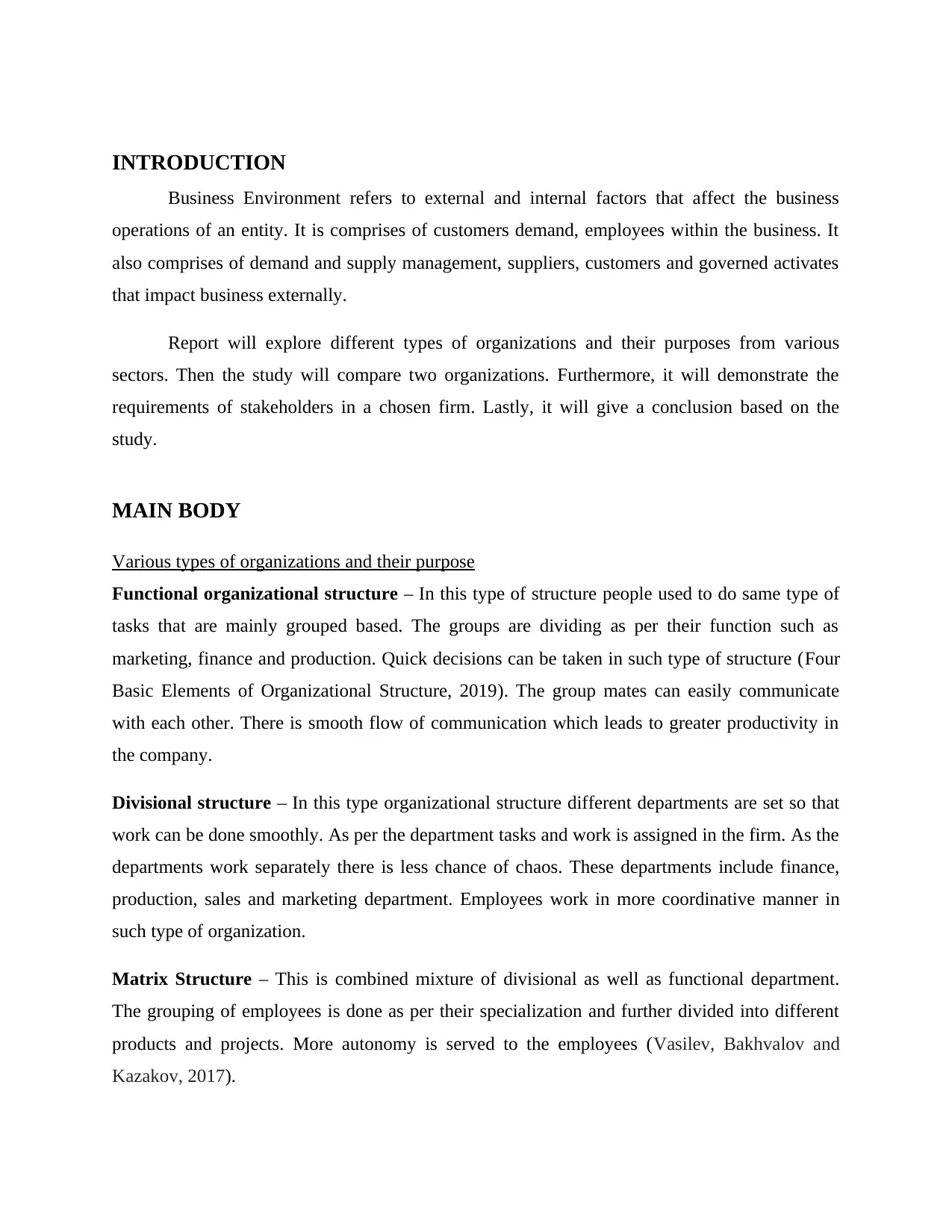
INTRODUCTION
Business Environment refers to external and internal factors that affect the business
operations of an entity. It is comprises of customers demand, employees within the business. It
also comprises of demand and supply management, suppliers, customers and governed activates
that impact business externally.
Report will explore different types of organizations and their purposes from various
sectors. Then the study will compare two organizations. Furthermore, it will demonstrate the
requirements of stakeholders in a chosen firm. Lastly, it will give a conclusion based on the
study.
MAIN BODY
Various types of organizations and their purpose
Functional organizational structure – In this type of structure people used to do same type of
tasks that are mainly grouped based. The groups are dividing as per their function such as
marketing, finance and production. Quick decisions can be taken in such type of structure (Four
Basic Elements of Organizational Structure, 2019). The group mates can easily communicate
with each other. There is smooth flow of communication which leads to greater productivity in
the company.
Divisional structure – In this type organizational structure different departments are set so that
work can be done smoothly. As per the department tasks and work is assigned in the firm. As the
departments work separately there is less chance of chaos. These departments include finance,
production, sales and marketing department. Employees work in more coordinative manner in
such type of organization.
Matrix Structure – This is combined mixture of divisional as well as functional department.
The grouping of employees is done as per their specialization and further divided into different
products and projects. More autonomy is served to the employees (Vasilev, Bakhvalov and
Kazakov, 2017).
Business Environment refers to external and internal factors that affect the business
operations of an entity. It is comprises of customers demand, employees within the business. It
also comprises of demand and supply management, suppliers, customers and governed activates
that impact business externally.
Report will explore different types of organizations and their purposes from various
sectors. Then the study will compare two organizations. Furthermore, it will demonstrate the
requirements of stakeholders in a chosen firm. Lastly, it will give a conclusion based on the
study.
MAIN BODY
Various types of organizations and their purpose
Functional organizational structure – In this type of structure people used to do same type of
tasks that are mainly grouped based. The groups are dividing as per their function such as
marketing, finance and production. Quick decisions can be taken in such type of structure (Four
Basic Elements of Organizational Structure, 2019). The group mates can easily communicate
with each other. There is smooth flow of communication which leads to greater productivity in
the company.
Divisional structure – In this type organizational structure different departments are set so that
work can be done smoothly. As per the department tasks and work is assigned in the firm. As the
departments work separately there is less chance of chaos. These departments include finance,
production, sales and marketing department. Employees work in more coordinative manner in
such type of organization.
Matrix Structure – This is combined mixture of divisional as well as functional department.
The grouping of employees is done as per their specialization and further divided into different
products and projects. More autonomy is served to the employees (Vasilev, Bakhvalov and
Kazakov, 2017).
⊘ This is a preview!⊘
Do you want full access?
Subscribe today to unlock all pages.

Trusted by 1+ million students worldwide
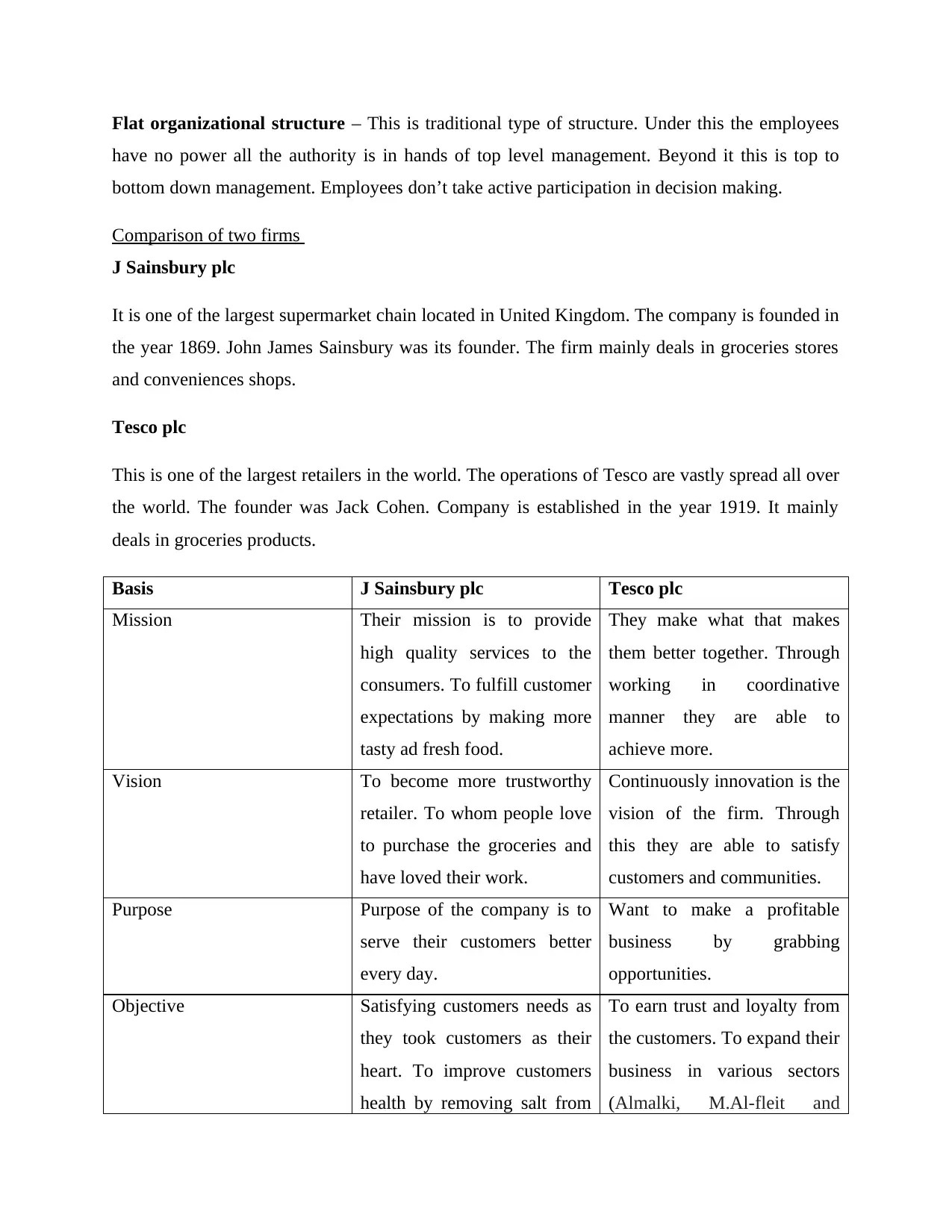
Flat organizational structure – This is traditional type of structure. Under this the employees
have no power all the authority is in hands of top level management. Beyond it this is top to
bottom down management. Employees don’t take active participation in decision making.
Comparison of two firms
J Sainsbury plc
It is one of the largest supermarket chain located in United Kingdom. The company is founded in
the year 1869. John James Sainsbury was its founder. The firm mainly deals in groceries stores
and conveniences shops.
Tesco plc
This is one of the largest retailers in the world. The operations of Tesco are vastly spread all over
the world. The founder was Jack Cohen. Company is established in the year 1919. It mainly
deals in groceries products.
Basis J Sainsbury plc Tesco plc
Mission Their mission is to provide
high quality services to the
consumers. To fulfill customer
expectations by making more
tasty ad fresh food.
They make what that makes
them better together. Through
working in coordinative
manner they are able to
achieve more.
Vision To become more trustworthy
retailer. To whom people love
to purchase the groceries and
have loved their work.
Continuously innovation is the
vision of the firm. Through
this they are able to satisfy
customers and communities.
Purpose Purpose of the company is to
serve their customers better
every day.
Want to make a profitable
business by grabbing
opportunities.
Objective Satisfying customers needs as
they took customers as their
heart. To improve customers
health by removing salt from
To earn trust and loyalty from
the customers. To expand their
business in various sectors
(Almalki, M.Al-fleit and
have no power all the authority is in hands of top level management. Beyond it this is top to
bottom down management. Employees don’t take active participation in decision making.
Comparison of two firms
J Sainsbury plc
It is one of the largest supermarket chain located in United Kingdom. The company is founded in
the year 1869. John James Sainsbury was its founder. The firm mainly deals in groceries stores
and conveniences shops.
Tesco plc
This is one of the largest retailers in the world. The operations of Tesco are vastly spread all over
the world. The founder was Jack Cohen. Company is established in the year 1919. It mainly
deals in groceries products.
Basis J Sainsbury plc Tesco plc
Mission Their mission is to provide
high quality services to the
consumers. To fulfill customer
expectations by making more
tasty ad fresh food.
They make what that makes
them better together. Through
working in coordinative
manner they are able to
achieve more.
Vision To become more trustworthy
retailer. To whom people love
to purchase the groceries and
have loved their work.
Continuously innovation is the
vision of the firm. Through
this they are able to satisfy
customers and communities.
Purpose Purpose of the company is to
serve their customers better
every day.
Want to make a profitable
business by grabbing
opportunities.
Objective Satisfying customers needs as
they took customers as their
heart. To improve customers
health by removing salt from
To earn trust and loyalty from
the customers. To expand their
business in various sectors
(Almalki, M.Al-fleit and
Paraphrase This Document
Need a fresh take? Get an instant paraphrase of this document with our AI Paraphraser
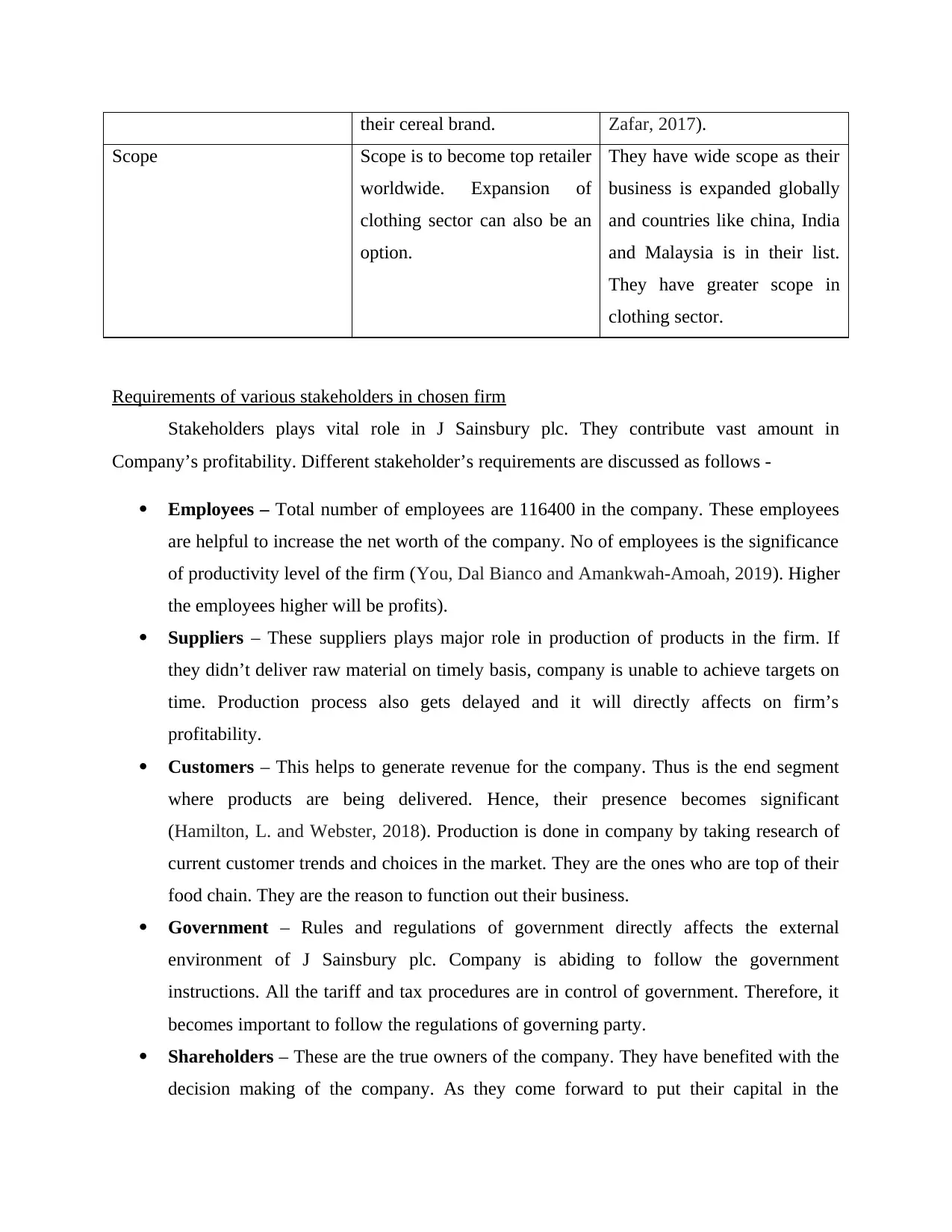
their cereal brand. Zafar, 2017).
Scope Scope is to become top retailer
worldwide. Expansion of
clothing sector can also be an
option.
They have wide scope as their
business is expanded globally
and countries like china, India
and Malaysia is in their list.
They have greater scope in
clothing sector.
Requirements of various stakeholders in chosen firm
Stakeholders plays vital role in J Sainsbury plc. They contribute vast amount in
Company’s profitability. Different stakeholder’s requirements are discussed as follows -
Employees – Total number of employees are 116400 in the company. These employees
are helpful to increase the net worth of the company. No of employees is the significance
of productivity level of the firm (You, Dal Bianco and Amankwah-Amoah, 2019). Higher
the employees higher will be profits).
Suppliers – These suppliers plays major role in production of products in the firm. If
they didn’t deliver raw material on timely basis, company is unable to achieve targets on
time. Production process also gets delayed and it will directly affects on firm’s
profitability.
Customers – This helps to generate revenue for the company. Thus is the end segment
where products are being delivered. Hence, their presence becomes significant
(Hamilton, L. and Webster, 2018). Production is done in company by taking research of
current customer trends and choices in the market. They are the ones who are top of their
food chain. They are the reason to function out their business.
Government – Rules and regulations of government directly affects the external
environment of J Sainsbury plc. Company is abiding to follow the government
instructions. All the tariff and tax procedures are in control of government. Therefore, it
becomes important to follow the regulations of governing party.
Shareholders – These are the true owners of the company. They have benefited with the
decision making of the company. As they come forward to put their capital in the
Scope Scope is to become top retailer
worldwide. Expansion of
clothing sector can also be an
option.
They have wide scope as their
business is expanded globally
and countries like china, India
and Malaysia is in their list.
They have greater scope in
clothing sector.
Requirements of various stakeholders in chosen firm
Stakeholders plays vital role in J Sainsbury plc. They contribute vast amount in
Company’s profitability. Different stakeholder’s requirements are discussed as follows -
Employees – Total number of employees are 116400 in the company. These employees
are helpful to increase the net worth of the company. No of employees is the significance
of productivity level of the firm (You, Dal Bianco and Amankwah-Amoah, 2019). Higher
the employees higher will be profits).
Suppliers – These suppliers plays major role in production of products in the firm. If
they didn’t deliver raw material on timely basis, company is unable to achieve targets on
time. Production process also gets delayed and it will directly affects on firm’s
profitability.
Customers – This helps to generate revenue for the company. Thus is the end segment
where products are being delivered. Hence, their presence becomes significant
(Hamilton, L. and Webster, 2018). Production is done in company by taking research of
current customer trends and choices in the market. They are the ones who are top of their
food chain. They are the reason to function out their business.
Government – Rules and regulations of government directly affects the external
environment of J Sainsbury plc. Company is abiding to follow the government
instructions. All the tariff and tax procedures are in control of government. Therefore, it
becomes important to follow the regulations of governing party.
Shareholders – These are the true owners of the company. They have benefited with the
decision making of the company. As they come forward to put their capital in the
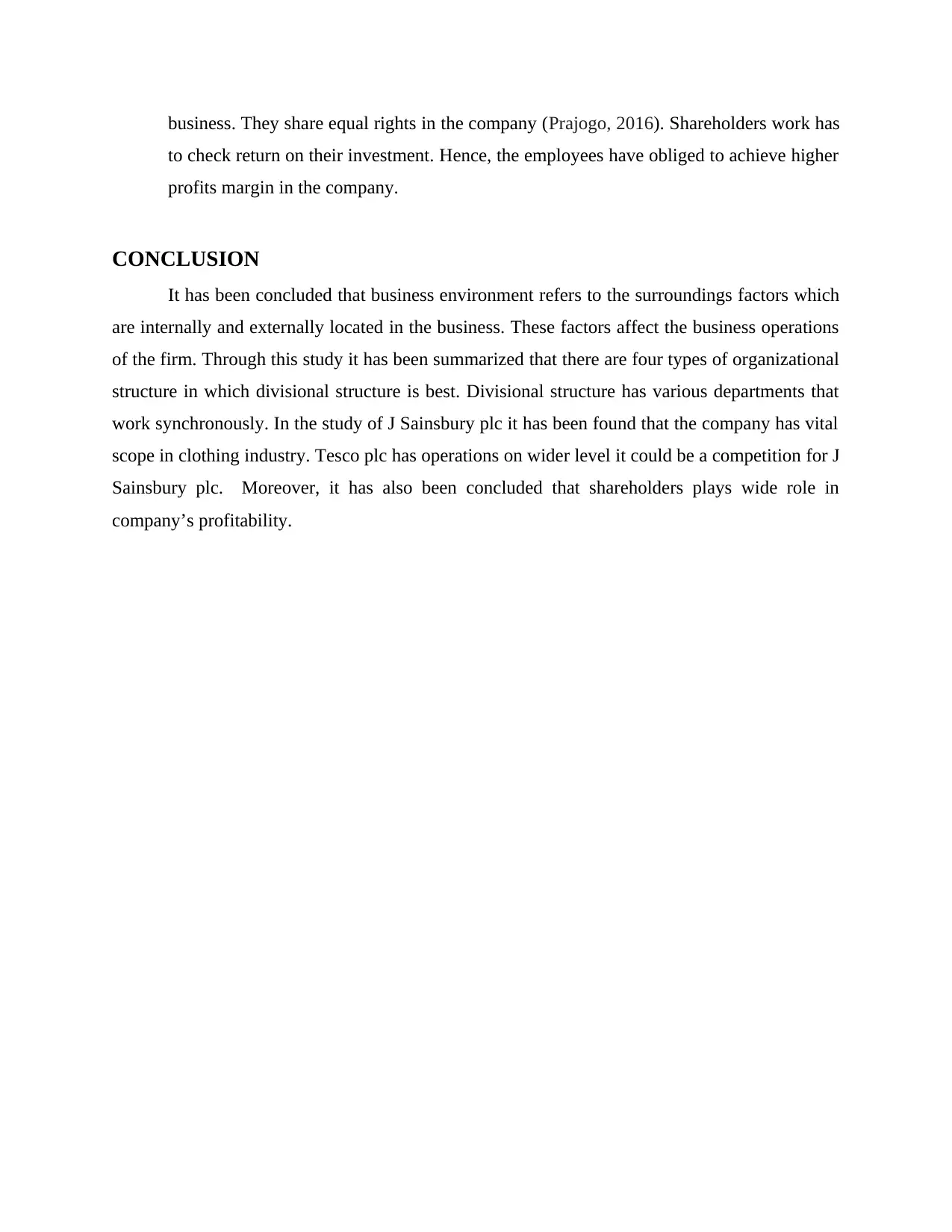
business. They share equal rights in the company (Prajogo, 2016). Shareholders work has
to check return on their investment. Hence, the employees have obliged to achieve higher
profits margin in the company.
CONCLUSION
It has been concluded that business environment refers to the surroundings factors which
are internally and externally located in the business. These factors affect the business operations
of the firm. Through this study it has been summarized that there are four types of organizational
structure in which divisional structure is best. Divisional structure has various departments that
work synchronously. In the study of J Sainsbury plc it has been found that the company has vital
scope in clothing industry. Tesco plc has operations on wider level it could be a competition for J
Sainsbury plc. Moreover, it has also been concluded that shareholders plays wide role in
company’s profitability.
to check return on their investment. Hence, the employees have obliged to achieve higher
profits margin in the company.
CONCLUSION
It has been concluded that business environment refers to the surroundings factors which
are internally and externally located in the business. These factors affect the business operations
of the firm. Through this study it has been summarized that there are four types of organizational
structure in which divisional structure is best. Divisional structure has various departments that
work synchronously. In the study of J Sainsbury plc it has been found that the company has vital
scope in clothing industry. Tesco plc has operations on wider level it could be a competition for J
Sainsbury plc. Moreover, it has also been concluded that shareholders plays wide role in
company’s profitability.
⊘ This is a preview!⊘
Do you want full access?
Subscribe today to unlock all pages.

Trusted by 1+ million students worldwide
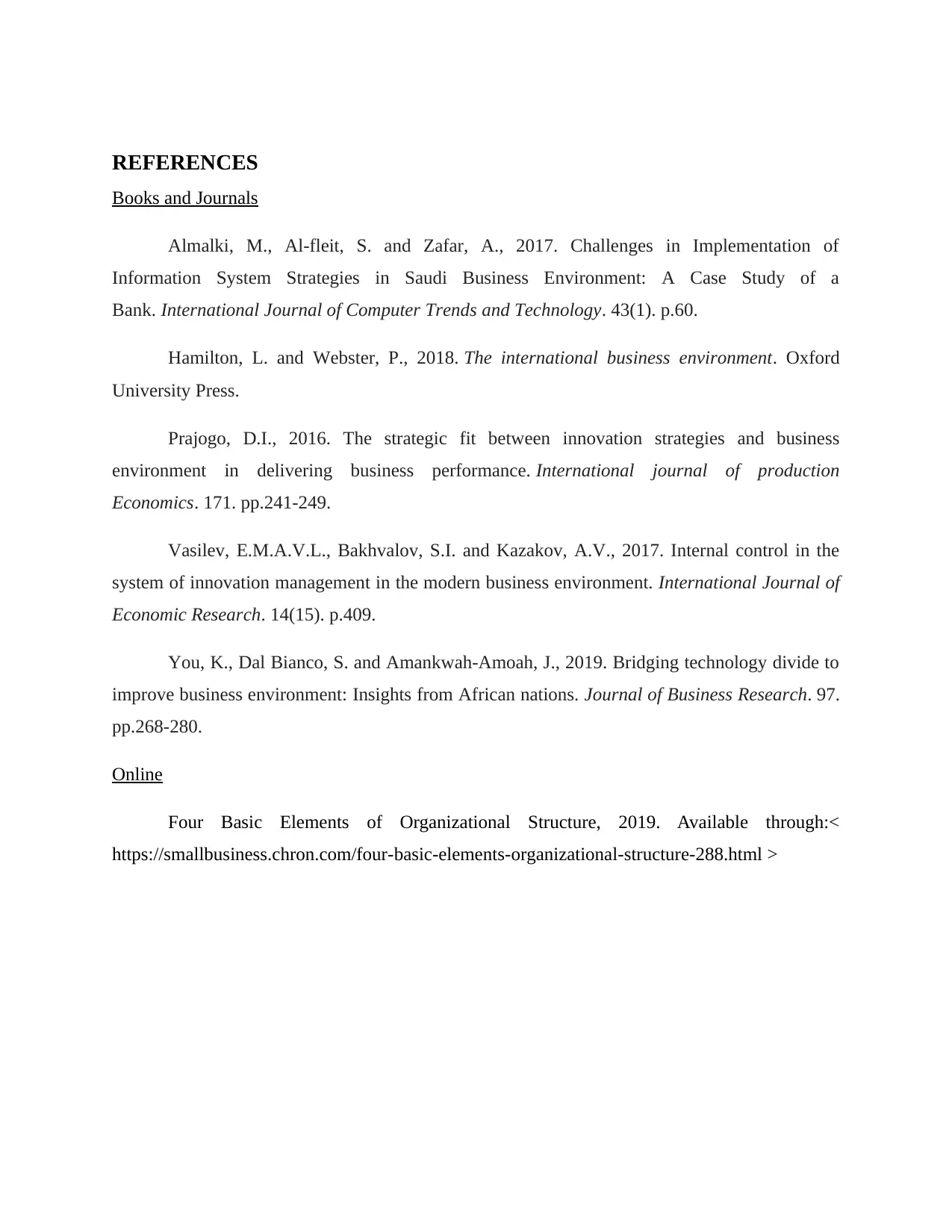
REFERENCES
Books and Journals
Almalki, M., Al-fleit, S. and Zafar, A., 2017. Challenges in Implementation of
Information System Strategies in Saudi Business Environment: A Case Study of a
Bank. International Journal of Computer Trends and Technology. 43(1). p.60.
Hamilton, L. and Webster, P., 2018. The international business environment. Oxford
University Press.
Prajogo, D.I., 2016. The strategic fit between innovation strategies and business
environment in delivering business performance. International journal of production
Economics. 171. pp.241-249.
Vasilev, E.M.A.V.L., Bakhvalov, S.I. and Kazakov, A.V., 2017. Internal control in the
system of innovation management in the modern business environment. International Journal of
Economic Research. 14(15). p.409.
You, K., Dal Bianco, S. and Amankwah-Amoah, J., 2019. Bridging technology divide to
improve business environment: Insights from African nations. Journal of Business Research. 97.
pp.268-280.
Online
Four Basic Elements of Organizational Structure, 2019. Available through:<
https://smallbusiness.chron.com/four-basic-elements-organizational-structure-288.html >
Books and Journals
Almalki, M., Al-fleit, S. and Zafar, A., 2017. Challenges in Implementation of
Information System Strategies in Saudi Business Environment: A Case Study of a
Bank. International Journal of Computer Trends and Technology. 43(1). p.60.
Hamilton, L. and Webster, P., 2018. The international business environment. Oxford
University Press.
Prajogo, D.I., 2016. The strategic fit between innovation strategies and business
environment in delivering business performance. International journal of production
Economics. 171. pp.241-249.
Vasilev, E.M.A.V.L., Bakhvalov, S.I. and Kazakov, A.V., 2017. Internal control in the
system of innovation management in the modern business environment. International Journal of
Economic Research. 14(15). p.409.
You, K., Dal Bianco, S. and Amankwah-Amoah, J., 2019. Bridging technology divide to
improve business environment: Insights from African nations. Journal of Business Research. 97.
pp.268-280.
Online
Four Basic Elements of Organizational Structure, 2019. Available through:<
https://smallbusiness.chron.com/four-basic-elements-organizational-structure-288.html >
1 out of 7
Related Documents
Your All-in-One AI-Powered Toolkit for Academic Success.
+13062052269
info@desklib.com
Available 24*7 on WhatsApp / Email
![[object Object]](/_next/static/media/star-bottom.7253800d.svg)
Unlock your academic potential
Copyright © 2020–2025 A2Z Services. All Rights Reserved. Developed and managed by ZUCOL.





